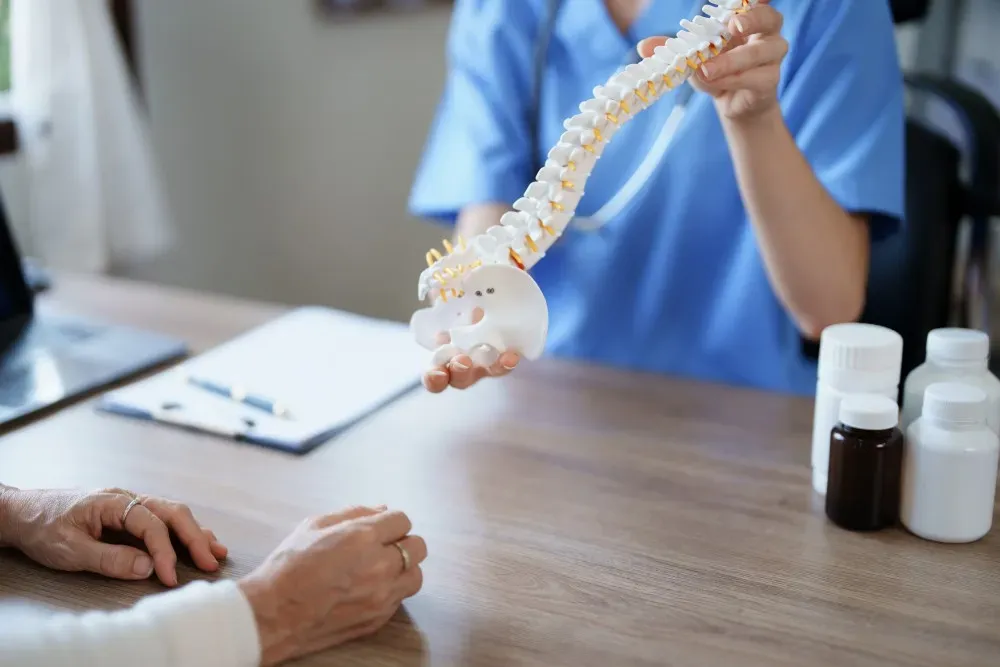Neurosurgery & Orthopedic Surgeons in Jacksonville

What is Arthritis of the Spine?
Arthritis is an umbrella term that includes all injuries and conditions of the joints. The primary symptoms are pain, inflammation and stiffness in the affected joints.
Arthritis is an umbrella term that includes all injuries and conditions of the joints. The primary symptoms are pain, inflammation and stiffness in the affected joints. Arthritis is a chronic condition with no cure, but the symptoms and pain can be controlled and managed with proper treatment.
Arthritis of the spine develops when pain, inflammation and stiffness occurs in the joints of the spine or at the sites where ligaments and tendons attach to the vertebrae of the spine. It can occur anywhere along the spine, but it develops most commonly in the low back and neck.
Keep reading to learn more about the different types of spinal arthritis and treatment options.
COMMON FORMS OF SPINE ARTHRITIS
There are over 100 different forms of arthritis and many of them can affect the spine. The most common causes of spinal arthritis are wear, tear and degeneration of the spine and autoimmune disorders. Osteoarthritis and ankylosing spondylitis are 2 types of arthritis that frequently develop in the spine.
1.) Osteoarthritis. The most common type of arthritis of the spine is osteoarthritis. Osteoarthritis is a degenerative disease caused by wear, tear and joint damage in the spine. Age, a history of back injuries and overuse from repetitive motions can cause the cartilage between spinal joints to break down, causing pain and inflammation at the joint sites. Although osteoarthritis is a non-inflammatory form of arthritis, it does cause inflammation at the affected sites. Most people develop spine osteoarthritis in the low back.
2.) Ankylosing spondylitis. Ankylosing spondylitis is an inflammatory form of arthritis. It causes inflammation at the spinal joints and at the sites where tendons and ligaments attach to the vertebrae. Joint pain and stiffness can develop and progress anywhere from the neck (cervical spine) to the sacroiliac joints in the sacrum.
Other types of inflammatory arthritis can develop in the spine, but these forms occur less frequently:
- Rheumatoid arthritis
- Psoriatic arthritis
- Reactive arthritis
- Enteropathic arthritis
SIGNS, SYMPTOMS AND RISK FACTORS
The primary symptoms of arthritis of the spine are pain, stiffness and loss of flexibility and mobility in the spine. You might experience swelling and tenderness around the affected joint(s). Pain and stiffness is usually worse early in the morning and at night, but may recede with movement during the day.
Risk factors for developing spinal osteoarthritis include:
- Age
- Obesity
- Genetics
- Performing a job or activity that places repetitive stress on joints
If you have a chronic inflammatory autoimmune disorder — such as psoriasis, inflammatory bowel disease, lupus and gout — you have a higher risk of developing inflammatory spinal arthritis.
TREATMENT OPTIONS
While treatment cannot cure spinal arthritis, the goal of treatment is to relieve pain, inflammation, stiffness and loss of joint mobility so that arthritis symptoms don’t interfere with everyday activities. Some treatments will vary depending on the type of arthritis you have. Your treatment plan will probably include the following options:
1.) Pain medications. Over-the-counter pain medications can help ease pain and reduce inflammation. If OTC medications aren’t effective, your doctor may prescribe stronger prescription painkillers.
2.) Anti-inflammatory medications. If you have an inflammatory form of arthritis, your doctor may prescribe medications that blocks inflammation and slows down disease progression.
3.) Steroid injections. Corticosteroid injections may temporarily ease inflammation and irritation around the affected joint. The effects of the injections wear off over time.
4.) Physical therapy. Physical therapy can help improve muscle and joint strength and range of motion. Your therapist can lead you through stretches and exercises that strengthen core and back muscles, and increase flexibility in the spine. A physical therapist can also provide posture and body positioning training.
5.) Surgery. Surgery is recommended in cases where conservative treatment isn’t effective to control pain or where the ability to function normally is impaired. Common surgical procedures may be a spinal fusion to stabilize the spine or a decompression to relieve pressure on the spinal cord and nerves.
Some people also find pain relief from using hot and cold compresses or massages.
LONG-TERM OUTLOOK
Arthritis is a degenerative long-term condition that can’t be reversed. Many people live with chronic back and neck pain from it. In some cases, osteoarthritis of the spine can contribute to other spinal issues, including:
- Bone spurs
- Spinal stenosis
- Nerve compression
Ankylosing spondylitis can also contribute to additional spine problems, including:
- Stress fractures
- Collapsed vertebrae
- Kyphosis
For people living with arthritis of the spine, self-management at home can help relieve pain and inflammation, maintain joint mobility and prevent further damage. Patients should strive to exercise regularly to improve muscle and joint strength, lose excess weight and practice good body posture and body positioning while sitting, standing and lifting heavy loads.
Following your prescribed treatment plan and making positive lifestyle changes can help you perform daily activities pain-free and live an active lifestyle.
CONTACT INTEGRITY SPINE AND ORTHOPEDICS FOR SPINE TREATMENT
At Integrity Spine and Orthopedics, we provide treatment options for patients with a wide range of back, spine and joint conditions. If you’re living with acute or chronic pain, we have orthopedic care and pain management services available. Our board-certified orthopedic doctors specialize in minimally invasive spine procedures to ease pain, inflammation and pressure in the spine.
To schedule a consultation, call 904-456-0017 or fill out our online form. If you’d like a second opinion on an existing diagnosis, we also offer a free MRI review to qualified patients.




